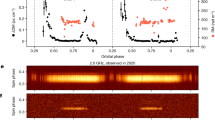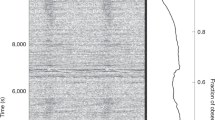Abstract
Much of the interesting physics concerning neutron stars and their evolution depends for its experimental foundation on observations of the rotation rates of pulsars. To continue recent efforts of our group in this area1–3, we began a series of pulse-arrival-time observations of ∼70 pulsars in January 1985. Most of the pulsars in this study were discovered in the Princeton/NRAO pulsar survey of the preceding two years4,5. Soon after we began these observations it became clear that PSR2303+46 was a binary pulsar2; it is now evident that PSR1831–00 is also a member of a binary system, the seventh such radio pulsar known. It moves in an orbit with a period of 1.81 days, a small eccentricity, and an unusually small mass function of 0.00012 M⊙ (where M⊙ is the mass of the Sun). With a period P = 0.521 s and period derivative P≲ 10−17 s s−1, PSR1831–00, like the other known binary pulsars, has a relatively weak magnetic field. We discuss the features of this system that provide clues to its evolutionary history and outline possible models for its formation.
This is a preview of subscription content, access via your institution
Access options
Subscribe to this journal
Receive 51 print issues and online access
$199.00 per year
only $3.90 per issue
Buy this article
- Purchase on Springer Link
- Instant access to full article PDF
Prices may be subject to local taxes which are calculated during checkout
Similar content being viewed by others
References
Davis, M. M., Taylor, J. H., Weisberg, J. M. & Backer, D. C. Nature 315, 547–550 (1985).
Stokes, G. H., Taylor, J. H. & Dewey, R. J. Astrophys. J. 294, L21–L24 (1985).
Rawley, L. A., Taylor, J. H. & Davis, M. M. Nature 319, 383–384 (1986).
Dewey, R. J., Taylor, J. H., Weisberg, J. M. & Stokes, G. H. Astrophys. J. 294, L25–L29 (1985).
Stokes, G. H., Taylor, J. H., Weisberg, J. M. & Dewey, R. J. Nature 317, 787–788 (1985).
Segelstein, D. J., Rawley, L. A., Stinebring, D. R., Fruchter, A.S. & Taylor, J. H. Nature(1986).
Manchester, R. N. & Taylor, J. H. Pulsars (Freeman, San Francisco, 1977).
van den Heuvel, E. P. J. J. Astrophys. Astr. 5, 209–233 (1984).
Taylor, J. H. & Stinebring, D. R. A. Rev. Astr. Astrophys. (in the press).
Anderson, B. & Lyne, A. G. Nature 303, 597–599 (1983).
Lyne, A. G., Manchester, R. N. & Taylor, J. H. Mon. Not. R. astr. Soc. 213, 613–639 (1985).
Lecar, M., Wheeler, J. C. & McKee, C. F. Astrophys. J. 205, 556–562 (1976).
Tamm, R. E., Bodenheimer, P. & Ostriker, J. P. Astrophys. J. 222, 269–280 (1978).
Trimble, V. J. Astrophys. Astr. 5, 389–402 (1984).
Author information
Authors and Affiliations
Rights and permissions
About this article
Cite this article
Dewey, R., Maguire, C., Rawley, L. et al. Binary pulsar with a very small mass function. Nature 322, 712–714 (1986). https://doi.org/10.1038/322712a0
Received:
Accepted:
Issue Date:
DOI: https://doi.org/10.1038/322712a0
This article is cited by
-
Thin accretion disc with a corona in a central magnetic field
Astrophysics and Space Science (2008)
-
Pulsars: their origin and evolution
The Astronomy and Astrophysics Review (1989)
-
Constraints on the equation of state for neutron stars implied by PSR1957 + 20
Nature (1988)
-
Accretion effects on compact members of binary stars
Journal of Astrophysics and Astronomy (1988)
-
Formation of binary radio pulsars
Astrophysics (1988)
Comments
By submitting a comment you agree to abide by our Terms and Community Guidelines. If you find something abusive or that does not comply with our terms or guidelines please flag it as inappropriate.



